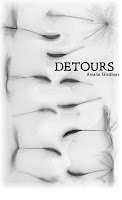 |
| The beginning |
 |
| Directions were meant to be changed. |
One definition of a detour, from the OED on line: A turning or deviation from the direct road; a roundabout or circuitous way, course, or proceeding. That’s certainly the kind of trip described in
Detours.
“Detour” can also describe the revision process. Revision often means reaching the intended destination by an unexpected route. It means keeping the end in sight while allowing for change, serendipity, or that harsh-sounding alternative, deviation. As if there were a clearly marked path that must be followed without fail; deviation brings punishment (shades of Little Red Riding Hood).
 |
| Go back! |
 |
| Try again. |
Revision might be avoidance: skip the pothole, the puddle, the flagger ahead, the expected delay–a roundabout evasion that can be a time-saver, or just the opposite.
 |
| Diverge, converge, diverge |
But destination is another of those fungible categories. To a point. Rewriting, reworking a piece can be a means to a different end. It can be a long and complicated route back to the beginning, trying to say what I thought I knew I was saying all along, or a circuitous route that leads somewhere else–a longcut, not a shortcut, to a place I didn’t initially understand I needed to go.
 |
| Are we there yet? |
 |
| Go left. No, right. Go another way. |
As I’ve been collecting detour signs, I’ve noticed the designers of those alternate routes are revising as well. Maybe not quite making it up as they go along, but reconsidering, reusing. Stockpiling against future need. There are models everywhere of ways to write, ways to think. As the traffic engineers responsibly recycle last project’s sign, I might joyfully find a place in this poem for the glowing line that wouldn’t fit in the last.
 |
| Summer possibilities |
 |
| Past or future route? |
Here, again, is one of my favorite detour signs, an evident work in progress:
 |
| “Path” may have been “route”? Ahead or behind? This way or that? |









